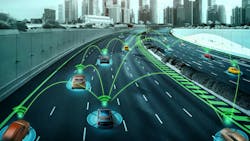Navigating the Road to Safer Intersections: What’s the Impact of V2X Infrastructure?
What you’ll learn:
- The impact of V2X infrastructure on roadways.
- Benefits of smart V2X intersections.
Vehicle-to-everything (V2X) communication makes it possible for vehicles to communicate with one another and with the environment. This technology is revolutionizing road safety by enabling drivers to know about dangers ahead without visibility.
On this front, a draft USDOT (U.S. Dept. of Transportation) V2X deployment plan is focused on signalized intersection deployment. These intersections operate with the assistance of a traffic signal, and they cyclically assign the right-of-way to a movement or combination of movements. As suggested by the ITS America deployment plan, signalized intersections provide a foundation for V2X deployment, including poles, power, electronics cabinets, and, in many cases, backhaul communications.
USDOT V2X Deployment Plan
The USDOT’s draft plan establishes ambitious targets for infrastructure deployment: By 2026, 25% of signalized intersections in the top 75 metro areas should be V2X-enabled; by 2029, this figure is expected to rise to 50%; and by 2034, the goal is to have 85% of signalized intersections equipped with V2X technology.
The life-saving potential depends on the infrastructure equipment type. The first type, termed “V2X infrastructure,” provides traffic-light timing. The second type, called “Smart V2X intersection,” incorporates features such as detection of vulnerable road users (VRUs) and vehicles running a red light. While the first type can mitigate red-light accidents by alerting drivers if their vehicle is unlikely to stop at a red light, the second type mitigates all signalized intersection accidents.
In 2021, red-light accidents, which can be mitigated by the first type of infrastructure, resulted in 1,109 fatalities according to IIHS. An estimated 127,000 people were injured. The potential for saving lives is linearly proportional to the V2X equipment ratio. However, even a cautious driver can be hit by a vehicle that runs a red light without V2X.
Analyzing the second type of infrastructure is conducted using data from the Fatality Analysis Reporting System (FARS). In 2021, 12% of vehicles involved in a fatal accident were near a signalized intersection, resulting in approximately 5,182 fatalities. The percentage of vehicles involved in injuries is even higher at 27%, equating to an estimated 689,000 injured people.
The life-saving potential with V2X surpasses that predicted by linear regression since a cautious driver can avoid an accident by getting warned of an approaching non-V2X vehicle running a red light.
Cost of Implementing V2X Infrastructure
The primary challenge of implementing Smart Intersection technology is cost. The expenses of deploying “V2X infrastructure” vary significantly depending on regional specifications and the existing readiness of cabinets for V2X integration.
ITS America (ITSA) estimates a typical range of $15,000 to $27,000. In contrast, a “smart V2X intersection” involves the addition of at least four detectors, such as cameras, radar, or LiDAR, to cover all roads entering the intersection. ITSA estimates the cost of such detection systems to be between $20,000 and $40,000, while the USDOT has set a target cost of $10,000 at scale. Roughly, a smart intersection doubles the cost of V2X infrastructure deployment.
Weighing life-saving potential and cost, a “smart V2X intersection” can save 2.5X more lives for the equivalent expenditure. These savings also ramp up faster, providing greater value in the early market. In addition, the car buyer will be more likely to buy a V2X once feeling safe in an intersection, even if other vehicles don’t have a V2X.
Overall, a basic V2X infrastructure deployment can save more than a thousand lives every year. However, smart V2X infrastructure saves 5X more lives and demonstrates greater efficiency in the early market. Now is the time to prioritize V2X to save lives on the roads as soon as possible.
About the Author

Onn Haran
CTO and Founder, Autotalks
Onn Haran brings over 20 years of experience in the communication industry. Prior to founding Autotalks, Onn was the CTO of Passave, the technology and market leader in Fiber-to-the-Home (FTTH) access solutions, founded in 2001 and acquired by PMC Sierra in 2006. Onn became a Fellow at PMC Sierra following acquisition.
Previously, Onn was the architect of Texas Instruments’ Bluetooth solution, and managed the ASIC R&D unit of the Israel Defense Forces. He has made significant contributions to standardizations, most notably, Bluetooth, IEEE802.3ah (EPON) and ITU g.984 (GPON) and has multiple patents in the field of communications. Onn holds a B.Sc. (cum laude) from the Technion, Israel Institute of Technology in Haifa, and an M.Sc. in electrical engineering from Tel-Aviv University.
